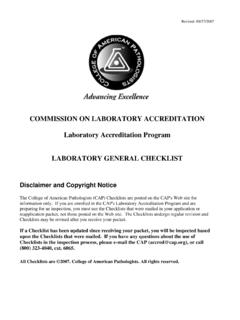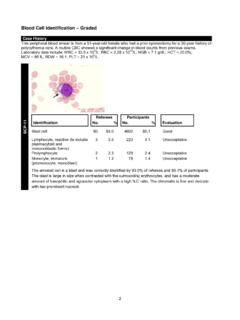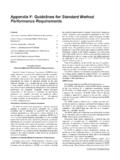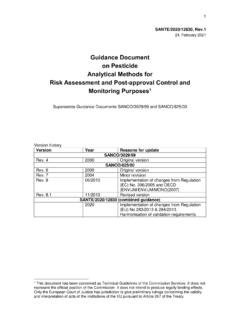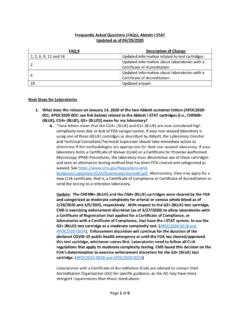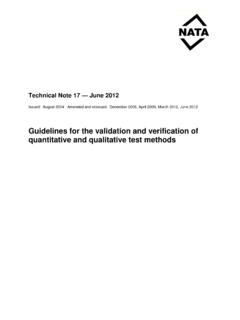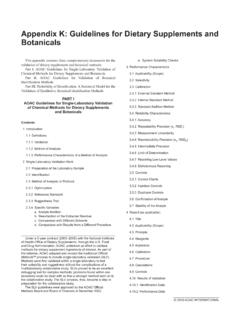Transcription of Analytical Measurement Range: Examples and Approaches ...
1 2013 Laboratory Accreditation Program Audioconferences and Webinars Analytical Measurement Range: Examples and Approaches William Castellani, MD, FCAP. March 20, 2013. Objectives Define and describe the Analytical y Measurement range g Compare this range to CLIA'88 requirements for calibration and calibration verification Discuss strategies for satisfying accreditation requirements q 2013 College of American Pathologists. All rights reserved. 2. Conflicts Nothing g to disclose 2013 College of American Pathologists. All rights reserved. 3. It All Begins Here Calibration means a pprocess of testing g and adjusting j g an instrument or test system to establish a correlation between the Measurement response and the concentration or amount of the substance that is being g measured by the test procedure. Calibration verification means the assaying of materials off known k concentration t ti ini the th same manner as patient ti t specimens to substantiate the instrument or test system's calibration throughout the reportable range for patient ti t test t t results.
2 Lt o Centers for Medicare and Medicaid Services, State Operations Manual, Appendix C. 2013 College of American Pathologists. All rights reserved. 4. Reportable p Range g Reportable p g means the span range p of test result values over which the laboratory can establish or verify the accuracy of the instrument or test system Measurement response. response o CLIA '88, Sec. , Definitions 2013 College of American Pathologists. All rights reserved. 5. Reportable Range Two components: p o The primary range of Measurement Analytical Measurement range Linear range o Anything done to the system to expand this range Dilution Dil ti Concentration The span of values that can be reliably measured using these modifications is the reportable range in CLIA'88. 2013 College of American Pathologists. All rights reserved. 6. What Must We Do? Validate or verifyy o Reportable range: as part of method validation /verification Initial documentation of the Analytical Measurement range Documentation of any dilution or concentration protocol that can be done to expand the range of values that can be reported by the method o Analytical Measurement range [verification]: every six months thereafter (when necessary).
3 2013 College of American Pathologists. All rights reserved. 7. How Do We Do It? Set criteria of acceptance p Established protocol M. Medical di l relevance l o All this should be established by the laboratory director o All this should be documented formally o The actual review mayy be delegated, g , though g final authorization may be reserved for the director 2013 College of American Pathologists. All rights reserved. 8. Reportable Range Mayy decrease the lower limit of the Analytical y Measurement range by: o Concentrating the sample Amicon concentrator Extraction and resuspension o Increasing the ratio of sample to reagent Altering the programming of the instrument 2013 College of American Pathologists. All rights reserved. 9. Reportable Range More commonly,y, mayy increase the upper pp limit of the Analytical Measurement range by: o Decreasing the ratio of sample to reagent o Diluting the sample before analysis 2013 College of American Pathologists.
4 All rights reserved. 10. Reportable Range Most often, the manufacturer p provides the information or mechanism for this modification o Autodilution/autoconcentration o Dilution protocol o Concentration protocol G. Goodd laboratory l b t practice ti would ld iinclude l d verifying if i ththatt these modifications work Going beyond the modifications stated in the manufacturer's instructions for use requires laboratory validation 2013 College of American Pathologists. All rights reserved. 11. AMR & RR Examples hCG AST. AMR: 3-1000 mIU/ml AMR: 4-900 U/L. RR lower limit: 5 RR lower: 4. RR upper pp limit: RR upper pp limit: not defined 1,000,000. Dilute and reassay until Values above upper RR. value l iis obtained bt i d reported t d as greater t than th 1,000,000. 2013 College of American Pathologists. All rights reserved. 12. General Principles Establish a target value o May use a patient sample's sample s result as the target . target o May use peer group mean of PT material o Mayy be established byy the p provider of the material Establish an acceptable range around the target o Mayy be an absolute ((arbitrary).)
5 Y) range g [[10%]]. o May use precision data for control material near the target o May be provided by the manufacturer Document your protocol (approved by director). 2013 College of American Pathologists. All rights reserved. 13. Verifying the Reportable Range Documenting g that the modifications to the sample p or method produce reliable results Begin with verifying the dilution protocol o Use the method manufacturer's recommended diluent and, if given, dilution factor o Determine an acceptance range for the dilution result If the manufacturer does not allow for dilution, then the laboratoryy must validate its own p protocol 2013 College of American Pathologists. All rights reserved. 14. Dilution Protocol Take samples near the upper limit of the Analytical range Manually dilute and assay Compare against the target using the acceptance p range g 2013 College of American Pathologists. All rights reserved. 15. Dilution Protocol Dilution Limit o If the manufacturer gives either a maximum dilution or a specific dilution, verify to the limit Report all results exceeding this diluted range as >.
6 Upper limit o If the manufacturer gives no guidelines: Laboratory director may specify a maximum diluted value or dilution protocol May dilute until you get a value (no upper limit). 2013 College of American Pathologists. All rights reserved. 16. No Upper Limit Take samples that exceed the upper limit of the Analytical range range. Manually dilute and assay 10. (should get a valid answer at the high end). Manually re-dilute 10. Compare against the target using the acceptance range. You have verified a 100 dilution;. at this point, the sample matrix is diluent, not serum/plasma. Any further dilution would not significantly change the matrix. Document this claim. 2013 College of American Pathologists. All rights reserved. 17. Verify Autodilution Method Take p patient samples p that p provide results on autodilution Manually dilute the sample o Do not need to use same dilution factor as the autodiluter Compare the autodilution and manual dilution results using the manual dilution result as target value 2013 College of American Pathologists.
7 All rights reserved. 18. Verify Autoconcentration Method Method, Part 1. For those methods where the lower limit is extended byy increasing the ratio of sample to reagent Take low samples p and serially y dilute o Suggest x 2 dilution Using the neat result of the sample as the target target, look for deviations from linearity 2013 College of American Pathologists. All rights reserved. 19. Example: Serum Immunoglobulin A. Manufacturer's range: 40 800 mg/dL. Dilution Value 1 Value 2 Mean Theoretical Neat 171 171 171 171. 2 87 88 88 86. 4 43 44 44 43. 8 20 20 20 21. 16 8 8 8 11. 32 3 3 3 5. 2013 College of American Pathologists. All rights reserved. 20. Verify Autoconcentration Method Method, Part 2. Once yyou've established the maximum concentration that will give reliable results, test samples using the modified concentration protocol programmed into the analyzer May need to first dilute sample into lower part of the Analytical Measurement range manually before placing on analyzer 2013 College of American Pathologists.
8 All rights reserved. 21. Example: Serum Immunoglobulin A. Neat result Manual Result (standard Result dilution protocol) (autoconcentration). 171 8 20 23. 51 2 26 24. 110 None 110 112. 88 None 88 89. 2013 College of American Pathologists. All rights reserved. 22. CLIA Requirement for Calibration/Calibration Verification : Calibration and calibration verification procedures d are required i d tto substantiate b t ti t ththe continued accuracy of the test system throughout the laboratory's y reportable p range g 2013 College of American Pathologists. All rights reserved. 23. Calibration/Calibration Verification Calibration: Establishes the relationship between analyte l t content t t andd instrument i t t measurementt signal i l Calibration verification: Confirms that the current calibration lib ti settings tti remaini valid lid 2013 College of American Pathologists. All rights reserved. 24. CAP Interpretation of CLIA Calibration Verification Validate the set p point ((CAP Calibration Verification)).
9 Prove response over the entire Analytical Measurement range g The Laboratory Accreditation Program considers calibration verification to be secondaryy to calibration o If calibration satisfies the CLIA requirements for calibration verification, no further action is necessary 2013 College of American Pathologists. All rights reserved. 25. Calibration Verification Requirements Sec. (b)(2). ( )( ) [Perform [ and document calibration verification procedures] Using the criteria verified or established by the laboratory . o (i) IIncluding l di ththe number, b ttype, andd concentration t ti off the materials, as well as acceptable limits for calibration verification; and o (ii) Including at least a minimal (or zero) value, a mid- point value, and a maximum value near the upper limit of the range to verify the laboratory's reportable range of test results for the test system 2013 College of American Pathologists. All rights reserved. 26. Frequency of Calibration OR Calibration Verification At least every 6 months When recommended by manufacturer After major maintenance or service When QC indicates At complete reagent change change, unless laboratory has data showing lot uniformity At change of critical reagents (laboratory defines).]
10 2013 College of American Pathologists. All rights reserved. 27. When is Calibration Sufficient? Quantitative No Assay? Special case: cut- off Yes Calibrate at least No Perform calibration every 6 verification at least months? every 6 months Yes 2013 College of American Pathologists. All rights reserved. 28. Calibrate at Least Every 6 Months Months . Yes Use at No Verify AMR. least 3. using l levels? l ? materials Yes near low, mid-point id i t Materials No and high span AMR values at Done (low-mid- least every high)? 6 months 2013 College of American Pathologists. All rights reserved. 29. Examples Laboratory calibrates: Verify Verify AMR? calibration? With 1 point daily No Yes With each new lot change (8-10 months). Yes Yes using 2 calibrators that span the AMR. Every 3-4 months with 5 calibrators that span the AMR No No Monthly with 2 calibrators that span the No Yes AMR. Every 3 months with 3 points (50, 150, 300) but reports 25-600. 25 600 No Yes Every run using kit material to determine Two concentrations a positive/negative cut-off No around the cut-off 2013 College of American Pathologists.


